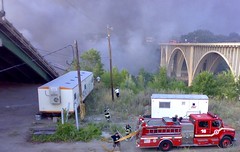City of Minneapolis Preplanning
In a presentation entitled "How Planning Pays Off" delivered to the Minnesota Pollution Control Agency's 2008 Air, Water, and Waste Environmental Conference, an outline was presented sharing details of the City of Minneapolis' disaster planning efforts prior to 35W bridge collapse. Also discussed was the direct impact of this planning. [1]
Since 2002, in the wake of the 9/11 attacks, Minneapolis has been taking action to ensure the most effective possible response to any catastrophic event. The foundation of the process was attended by representatives of the city and surrounding community at an Integrated Emergency Management Course in Mount Weather, Virginia. During this course, numerous disaster scenarios were practiced including chemical release, terrorist attack, structure collapse, and others. A major part of the course involved identifying shortcomings, and for Minneapolis these were communications, dispatch, structure collapse & hazardous materials readiness, water infrastructure security, discontinuous local planning, shortage of PPE (personal protective equipment) for responders, and city hall security. Having identified these, the city was able to address each of them by creating new plans and using federal grants and other resources for the material needs. An important part of this planning was clarification (and in some cases new development) of a regional system of Mutual Aid Partners - responders from surrounding communities who could coordinate rapidly and know when to stage resources locally versus rush to the scene of any event. In 2007, before the bridge collapse or any major incident and largely as a result of this course of planning, the Department of Homeland Security recognized Minneapolis as one of the nation's best prepared cities. [2]
A Minneapolis Fire Department crew rushes to the scene, in the vicinity of the burning Tastee truck and school bus. Photo by Flickr user yamkickan.
|

|
These plans were called in to action in August 2007 with the collapse of the 35W bridge. The federal government approved a Category B Disaster Declaration, freeing financial resources from FEMA and encouraging enhanced coordination between local, state, and federal agencies. City emergency services and Mutual Aid Partners responded near-perfectly, staging in their own regions when necessary to avoid worsening the congestion surrounding the scene, but coordinating with the Emergency Operations Center (EOC) in Minneapolis to get critical resources to the site. Emergency communications networks remained online and effective, including the public 911 telephone system, which experienced more than triple normal call volume for a sustained period of over two hours.[3]
Major successes derived from the preplanning efforts were identified as the immediate opening by the City of Minneapolis of the EOC in coordination with the National Incident Management System (NIMS), and the efficient, coordinated, informed response of Mutual Aid Partners. The Minneapolis Emergency Communications Center, operators of the 911 system, later received a national award for their efforts.[3] The presenter made it very clear that although this precise scenario was not among those practiced at Mount Weather, the response was dramatically more effective as a result of that course of assessment and subsequent planning. An unnamed city official later in the day referred to the entire cooperative operation as "a jewel of a response".

Clip from an August 16, 2007 news report featuring a member of the Moorhead Fire Department. His description offers insight in to how the Mutual Aid Partner and similar coordinated incident response systems are implemented, and emphasizes the value of preplanning and specialist training.
References:
1. Forte, Rocco. “How Planning Pays Off .” MPCA Air, Water, & Waste Environmental Conference. Bloomington, MN. Feb. 27, 2008.
2. “Few Get Top Federal Marks for Disaster Planning.“ New York Times Jan. 3 2007: A18
3. Minneapolis 911 Center Wins National Award. Government Technology. March 4, 2008.
Comments (0)
You don't have permission to comment on this page.